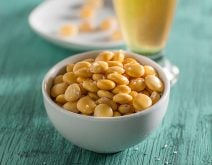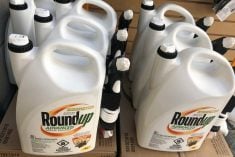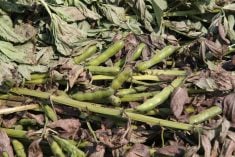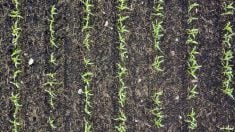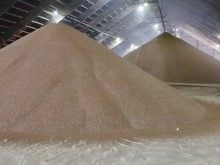[UPDATED: April 12, 2022] Terry Youzwa hasn’t grown faba beans for a couple of years, but he can see a time in the near future where the crop will be back in rotation with a good fit as one of the pulse crops regularly grown on his northeast Saskatchewan farm.
Youzwa, who farms with his son, Zak, and family members near Nipawin, says there are many good features about faba beans and there will be even more if plant breeders can develop earlier-maturing, more determinate growth varieties.
“As a director of the Saskatchewan Pulse Growers, that is one of the things I have been asking for is earlier-maturing faba beans,” says Youzwa. “They can grow very well in this area, but one disadvantage is if you get rain later in the year or even cloudy days, they don’t want to quit growing. Developing varieties with earlier maturity will definitely be an advantage.”
Youzwa, who grew faba beans for about five years, notes the crop has several important advantages. They can handle cooler, wetter soils, making it possible to seed them early in the spring. A big feature in the pulse crop world — they are resistant to aphanomyces root rot. Seeds inoculated with nitrogen-fixing rhizobium do the best job of any pulses for fixing nitrogen in the soil — the second year being better than the first. And, they stand well, so are easy to harvest.
Youzwa says he is excited to see pulse crop fractionation plants, particularly faba bean processors, being established and introducing new varieties that fit new markets, and also offer forward contracting and production contracting opportunities.
“I see these new fractionation plants with a very positive role to play in terms of faba bean production,” says Youzwa. “One of the disadvantages before was not being able to forward price the crop. So forward pricing and production contracts will be attractive to producers.” He says in the near future he expects faba beans will be back in rotation on his farm, probably alternating between faba beans and field peas each year.

New processing facility
That’s where Brad Goudy is hoping his Faba Canada Ltd. will play an important role in the growth of faba bean production in Western Canada.
Goudy, with the rights to an improved faba bean variety called Fabelle, is planning to have a faba bean fractionation plant up and running in Legal, Alta., just north of Edmonton, sometime this May. He has been offering production contracts to Alberta and Saskatchewan growers and plans to be processing between 12,000 to 25,000 tonnes of faba beans this year.
“With this new variety, with much improved nutritional components for both human food and livestock feed markets, it provides western Canadian farmers with an excellent opportunity to include faba beans in their rotation,” says Goudy.
With a contract price of $14 per bushel, Goudy was hoping to lock in about 15,000 acres of faba bean production this year. For more information visit the Faba Canada Ltd. website at fabacanada.com or call Goudy at 1-306-921-5995.
Faba bean is a crop that likes moisture, so it tends to have a better fit in the Parkland growing area or under irrigation. It can handle cooler, moist conditions making it ideal for early seeding, but particularly needs moisture in later summer to help pods fill and mature. One downside is that it’s a late-maturing crop, although it can be desiccated to complete ripening.
Goudy says while Fabelle is later maturing, farmers need to note even though the plant looks green, the seeds are ripe for harvesting.
From a food and feed nutritional standpoint, Goudy figures Fabelle will be an alternative or a replacement for the Snowbird variety of faba bean, which has been grown widely in Western Canada for several years.
Faba beans naturally have a couple of anti-nutritional components, which affect its desirability in most food and feed markets. It is a pulse crop that can be high in tannins — a naturally occurring chemical compound that gives it a bitter taste. The other anti-nutritional compounds are vicine/convicine, which can have an adverse effect on some humans, and can cause an allergic-type reaction known as favism.
Goudy says the good news with Fabelle is it’s extremely low in tannins as well as being extremely low in vicine/convicine. So it has a good fit in protein markets.
At the Legal processing plant, Goudy will be producing a high-quality protein product he says will have an excellent fit in food markets. He also plans to be selling “good-looking” (undamaged with good colour) whole beans to human food markets in Egypt.
And he also points to recent feed studies conducted by the University of Alberta and Gowans Feed Consulting that showed Fabelle faba bean was a top performer in hog feeding trials. Again, it is a variety that will have an excellent fit as livestock feed.
Goudy says in variety trial comparisons, Fabelle faba bean outyielded Snowbird faba bean by about six per cent in Saskatchewan trials and 13 per cent in Alberta trials.
“I am confident Fabelle faba beans will really provide farmers with an opportunity to include another high-quality and high-yielding pulse crop in rotation,” says Goudy. “With its improved nutritional profile, there has been a lot of interest in Fabelle in the food market, and it also has an excellent fit as a livestock feed as well.
“As we launch our first fractionation plant in Legal, I really believe that faba beans will be a key component in the future of the plant protein industry.” Goudy says he is starting out with a smaller processing facility at Legal, but will be able to move into a larger processing plant on-site as demand and markets increase.
*Update: a spelling error of Fabelle was corrected.





